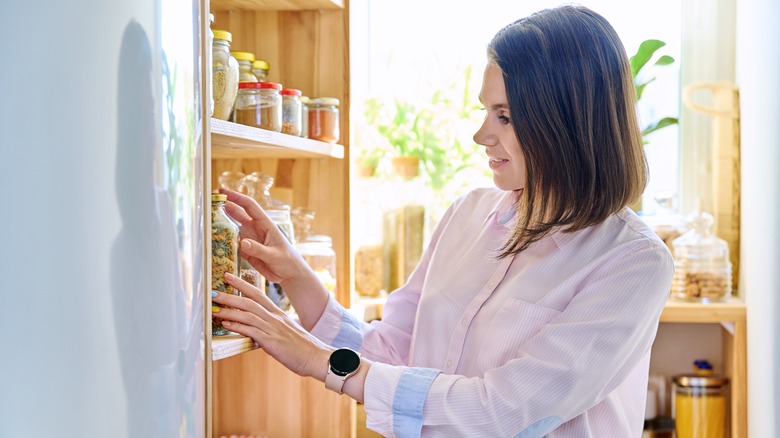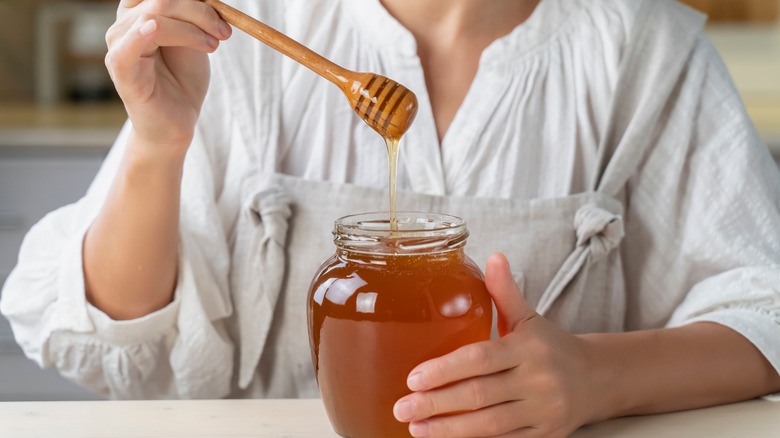The Unexpected Kitchen Staple You Should Keep In Mind When Traveling
Traveling is all about embracing the unknown. However, that sense of adventure and trying new things can also mean running into minor mishaps along the way. Whether it's scraping your knee during an ambitious hike, finding that the local cuisine doesn't agree with your stomach, or simply struggling to beat jet lag, being somewhere new is not without its fair share of challenges. Luckily, there's a simple, affordable, and easily accessible solution to many of these problems.
A kitchen staple renowned for its sweetening properties, honey is much more than an addition to your morning toast. In fact, it can be a budget-friendly remedy for a variety of travel troubles. Naturally antibacterial, according to Healthline, honey not only promotes healing from scrapes, burns, and other wounds, but it can also help soothe traveler's belly, ease a sore throat, and even take the edge off, per 2014 research published in Evidence-Based Complementary and Alternative Medicine. And the best part? It's easy to find no matter where you go and generally cheaper than its pharmaceutical counterparts.
The healing power of honey
Honey's history is as rich and complex as its flavor, with evidence of honey harvesting dating back to ancient times. Rock paintings in Spain, for example, estimated to be around 8,000 years old, depict early human interaction with bees — showcasing our long-standing relationship with this golden syrup and the insects that produce it.
From there, the tale of honey weaves through various ancient civilizations. The Egyptians and Greeks, among others, were some of the first to recognize honey's medicinal properties and incorporate it into their healing practices. Using honey to treat a wide range of conditions — from eye diseases to gastrointestinal discomfort — these ancient cultures pioneered a legacy that we continue to benefit from centuries later.
Today, naturists, nutritionists, and even dermatologists are quick to acknowledge honey's impressive capabilities. In medicine, for example, its potent anti-inflammatory and wound-healing properties make it a useful ingredient for treating minor injuries and skin conditions, according to Mayo Clinic. Meanwhile, in the beauty world, honey is celebrated for its moisturizing and antioxidant properties. Used in everything from facial masks to body scrubs, it helps hydrate the skin, fight signs of aging, and impart a natural glow, according to Gisou.
Other kitchen staples worth adding to your first aid kit
When putting together a DIY first aid kit, throwing in some everyday kitchen items can be a great way to save money. Sea salt, for example, isn't just a fundamental seasoning across the globe — The Good Human says it can also serve as an antiseptic solution. By dissolving it in water, you can create a rinse that'll clean wounds and help prevent infections. Similarly, garlic is also a great ally to have. Known for its antiviral properties, per Healthline, it can help boost your immune system and help ward off common travel bugs.
Apple cider vinegar, another widely-used kitchen staple, has plenty of other uses, too. From soothing sunburns to helping with digestive issues and acting as a natural insect repellent, this versatile ingredient can make the difference between an uncomfortable situation and a great trip. Lastly, don't forget about baking soda. This seemingly modest ingredient can serve as an anti-itch treatment, according to Medical News Today, for certain insect bites or rashes. Mix wiith water to create a paste and you can apply it directly to the affected area for quick relief.
At the end of the day, there are a variety of kitchen staples that make a strong case for the natural healing powers that already exist inside your cupboard. So, the next time you're struggling to get your hands on a certain medical supply, check your kitchen — you might just end up saving yourself time and money.


